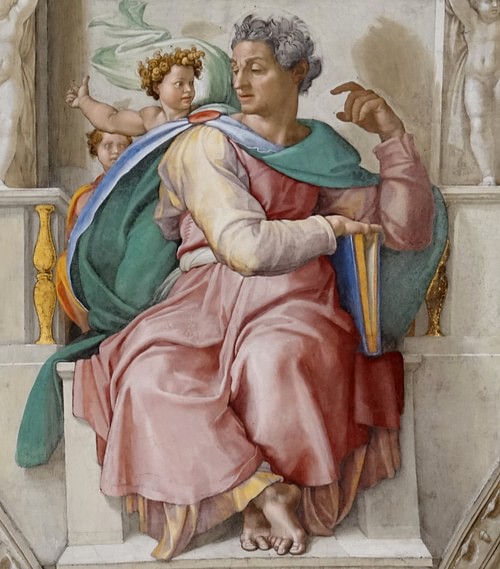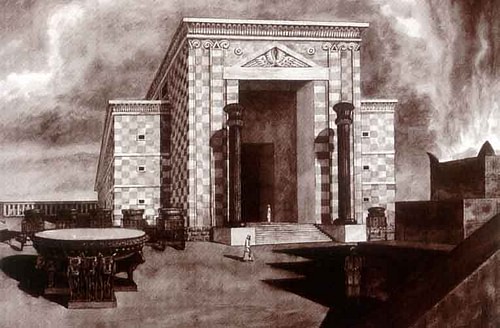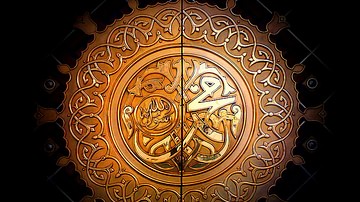
'God' is the common word for the identity of a higher being in the universe beyond our world, the creator of all known existence, and who rules in conjunction with lower gradients of divinity (angels). In Greek, theikos ("divine") meant to be god-like in attributes or power. Theology is thus the study of the nature of God and God's relationship with humans.
The English word 'god' first came into use through a German term applied in the 6th-century Christian Codex Argenteus, gudan ("to call" or "to invoke" a power). In Western traditions, 'God' is the God of Judaism, Christianity, and Islam. These three constitute the three Abrahamic faiths, as all three claim that this deity revealed himself to an ancient patriarch, Abraham. English Bibles distinguish this being from all other gods with a capital G.
Ancient Cultures
Ancient concepts of the universe posited the heavens (the abode of the gods), the earth (the place of humans), and the underworld (the place of the dead). Gods could transcend all three levels. Many ancient tribes promoted a local god or goddess as the founder of their clans. Some were elevated with the concept of a high god/goddess or a king/queen of the gods, who ruled over diverse gradients of powers in the universe.
Ancient religions also had creation myths, describing the way in which everything in the universe was created (most often out of chaos) and the formation of the first humans and human society. Myths validated contemporary law codes (rituals, behavior, and gender roles), which were thought to have originated with the gods and thus were deemed sacred.
Divine possession was the way ancient peoples communicated with their gods (the rituals and practices known as divination). Oracles were both people and places where a deity spoke through someone in a trance-like state. The Jewish equivalent was the prophets, whom God possessed and spoke through them to deliver messages to the people. Bibles distinguish the words of God by the introduction, "Thus says the Lord," and then the words are indented and structured like poetry.
The God of Israel
The book of Genesis in the Jewish Scriptures promoted this deity as the highest god of what would become the nation of Israel. God created and controlled the known elements of both the universe and everything on earth. The God of Israel acted alone, without a female consort, through speech: "And God said, 'Let there be light'" (Genesis 1:3). This was not unique; ancient Egyptian religion claimed the creator god Ptah created through speech. God created the first human couple, Adam and Eve, who were ordered to be fruitful and multiply.
A premier moment in Genesis is in chapter 12, the call of Abraham, from Ur in Mesopotamia. He was to be the father of a great nation (the meaning of his name change from Avram to Abraham) and would be given the land of Canaan as a prosperous land for his clans and herds. His descendants would be protected and prosperous as long as they honored and obeyed this God. God ordered Abraham and his descendants to perform circumcision, which functioned as a permanent, physical marker to distinguish this group from the other nations.
Ancient peoples developed contracts with their gods, spelling out the duties of each side. From the Hebrew "to cut" we have the term 'covenant,' a contract reflecting the ritual of cutting animal sacrifices in half while declaring an oath to a deity. There are several stories of the God of Israel joining in covenants with his people: the covenants with Noah, Abraham, Moses, and King David.
El
In some of the older texts from the region, el (plural: elohim) was a common form in Hittite, Ugaritic, paleo-Hebrew, Canaanite, and Aramaic for divine powers. At times El was understood as 'the god' to distinguish it from others, and often associated with creation. El was often combined with an attribute. In Abraham's second call by God in Genesis 17:1, this being was described as El-Shaddai, ("God almighty"). In Genesis 14:18-20, Abraham accepted a blessing of El Elyon ("most high") from Melchizedek, the king of Salem and priest of this god. The followers of this God became Israelites: "Your name will no longer be Jacob, but Israel, because you have struggled with God and with humans and have overcome." (Genesis 32:28)
Jews became a common term during the Persian occupation (6th century BCE), deriving from Yehudi, "those from the kingdom of Judah." During the reign of the Northern Israelite king Ahab and his wife Jezebel (871-852 BCE), Jezebel's family deities (ba'als, Levantine and Canaanite gods) were prominent. Through the work of the prophets Elijah and Elisha (in the book of Kings), the God of Israel was elevated to what we can deem a national god. The concept of God as a universal deity is found in Isaiah: "Do you not know? Have you not heard? The Lord is the everlasting God, the creator of the ends of the earth" (40:28).
Polytheism & Monotheism
From the time of the Enlightenment, world religions are divided between the polarities of polytheism (recognition and worship of more than one god) and monotheism (the belief in one god), while pantheism describes the recognition of several gods with gradients of authority and henotheism means the elevation of one god over many lower divinities.
The terms remain problematic because they were not common descriptors in the ancient world. It would be better to say that the ancients participated in religious pluralism. There was no contradiction in belonging to several different cults of specific gods. People did not articulate their concepts as belief or faith (Greek: pistis, "loyalty") the way we do now. They believed in their gods, but what was crucially important was performing the rituals and sacrifices correctly, as handed down from the gods to the ancestors. There was no such concept as ancient monotheism. All ancient people were polytheists in this sense, including the Jews.
Ancient Jews conceived of a hierarchy of powers in heaven that included a divine court: "sons of God" (Genesis 6:4), angels, archangels, cherubim, and seraphim. Jews also recognized the existence of demons (lower divinities) and introduced the concept of a fallen angel, which is the origin of Satan, the Devil.
In the Jewish Scriptures, the God of Israel (as the original creator) was responsible for creating "the other gods" and consistently referred to the existence of the gods of the nations: "Do not follow other gods" (Deuteronomy 6:14); "God presides in the great assembly; he renders judgment among the gods" (Psalm 82:1). In the story of the Jews' exodus from Egypt, God battled against the gods of Egypt to demonstrate who controls nature. This makes little sense if their existence was not recognized.
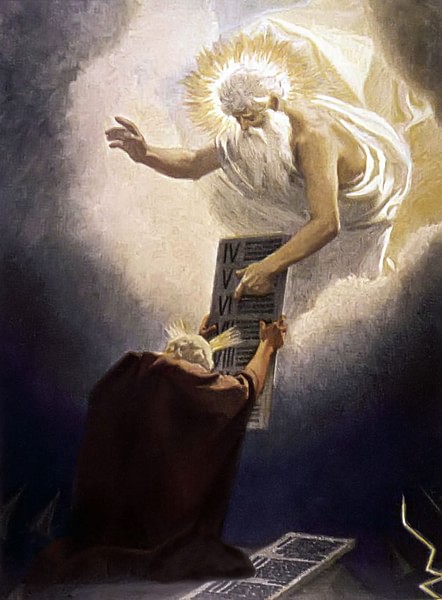
The foundational story for the idea that Jews were monotheistic was when Moses received the ten commandments of God on Mt. Sinai: "I am the Lord your God… You shall have no other gods before me" (Exodus 20:2-3). This does not indicate that other gods do not exist; it is a commandment that the Jews were not to worship any other gods. We combine worship with belief and veneration, but worship in the ancient world always meant sacrifices. Jews could pray to angels and other powers in heaven, but they were only to offer sacrifices to the God of Israel. This commandment was one of the major differences between Jews and all other traditional ethnic cults. This difference was promoted with the ban on images: "You shall not make for yourself an image in the form of anything in heaven above, on the earth beneath or in the waters below" (Exodus 20:4).
Yahweh
When Moses encountered a presence on Mount Sinai and asked him his name, "God said to Moses, 'I am who I am. This is what you are to say to the Israelites: I am has sent me to you'" (Exodus 3:14). Ancient Hebrew was written in consonants (with vowel sounds articulated and letters added later). From the four consonants in "I am who I am" (YHWH), comes Yahweh, also known as the Tetragrammaton, or the sacred name of God.
In Hebrew, ehyeh asher ehyeh is the first person singular of the verb 'to be.' One way in which to understand the form of the name is to relate it as an action verb. This is a God who acts, specifically by intervening at various times in the earthly realm of his people. The "I am" also indicated self-sufficiency, acting alone, as the primal creator and contingent upon no other powers.
However, Yahweh appeared in an earlier inscription in Egypt to commemorate the victories of Pharaoh Amenhotep III (c. 1400 BCE), which cited "enemies from the land of Shasu of Yahweh." Shasu was a specific group of nomads that may have constituted the Israelites. Yahweh may have been adopted much earlier than the story of Moses as the deity of these particular nomads. The 9th-century BCE stele erected by the Moabite king, Mesha, boasted that he defeated the king of Israel and took the vessels of Yahweh.
Jerusalem & Temple Worship
The books of Joshua and Judges described a period when the Israelites belonged to a tribal confederation of the descendants of the twelve sons of Jacob during the Iron Age (1200-600 BCE). Moses had placed the tablets of the law in a wooden chest, the Ark of the Covenant, which was housed in a portable tent shrine during the wilderness years. To avoid jealousy or dominance among the tribes, cult sites in various tribal sections took turns guarding the tent.
King Solomon (970-931 BCE) built the first temple in Jerusalem, which had been conquered by his father, King David. King Josiah (640-609 BCE) is credited with reforming the cult by eliminating local practices and centering the worship at this temple alone and to Yahweh alone. Some scholars consider that this is when Deuteronomy 6 was inserted, in what became a central prayer of Judaism, known as Shema Yisrael, "Hear, O Israel, Yahweh is our God, Yahweh is one."
The Ark of the Covenant was transferred to the Holy of Holies, the inner sanctum of the Temple. Moses was told: "There, above the cover between the two cherubim that are over the ark of the covenant law, I will meet with you and give you all my commands for the Israelites." (Exodus 25:22). The Ark represented the presence of God in the temple (as either his throne or footstool). This presence is what made the temple a sacred space, requiring the purity rules in the book of Leviticus when one approached the temple.
Appearance & Attributes
The God of Israel is described as aniconic, not depicted as a statue or other image. But this did not exclude symbolic or literary analogies. In fact, many pre-reform images of Yahweh, particularly in Northern Israel, utilized a common bull image (the golden calves of Jeroboam in 1 Kings), a symbol of fertility.
In Genesis 1:26-27 we read:
Then God said, "Let us make mankind in our image, in our likeness, so that they may rule over the fish in the sea and the birds in the sky, over the livestock and all the wild animals, and over all the creatures that move along the ground.' So God created mankind in his own image, in the image of God he created them; male and female he created them.
A more modern interpretation of this passage relates image to function. As God ruled all of creation, men and women were to rule as substitutional servants of God in the care of the earth. Given the social construction of gender and gender roles in antiquity, the God of Israel was always described as male. We have many anthropomorphic images ascribed to God, such as the face of God or the hand of God.

Rather than literal depictions, common descriptors are omnipotent (all-powerful), omniscient (all-knowing), and omnipresent. This latter concept coheres to the idea of transcendence, the ability to cross over the spatial areas of the known universe. Immanence is also a concept that at times the God of Israel manifested himself on earth in various ways to either save or punish his people. God utilized the prophets to urge repentance whenever they had sinned or neglected the commandments.
Hellenistic Judaism
After the conquests of Alexander the Great (r. 336-323 BCE), Greek culture, Greek government, and Greek religion were introduced into the Eastern Mediterranean. Educated Jews could participate in the various schools of Greek philosophy. Philosophers promoted the concept of an original high god beyond the parameters of the physical universe and utilized the literary devices of allegory and metaphor. As a pure, good essence, this being did not create but emanated lower powers who were responsible for creation. This oneness of the highest god was unified throughout the universe, being present in nature, materiality, and in humans in the concept of the soul. This interconnectedness was achieved through the emanation of a divine aspect of logos ("rationality," sometimes translated as "word").
The Jewish philosopher Philo of Alexandria (writing in the early decades of the 1st century CE), presented Judaism in light of Greek philosophical principles, claiming the same one high god as the God of Israel. Through allegory, Moses could be understood as the logos, who provided a system or reason and rationality through Mosaic Law.
Christianity: A Second God
In the decades of the 20s and 30s of the 1st century CE, Jesus of Nazareth, in the form of a traditional prophet, began preaching the imminence of the kingdom of God on earth. Positing a kingdom that was not Rome, he was executed by crucifixion (the punishment for treason) by the Roman procurator Pontius Pilate. After the trial and crucifixion of Jesus of Nazareth, his followers claimed that he was resurrected from the dead and exalted to God's side in heaven (Acts 7).
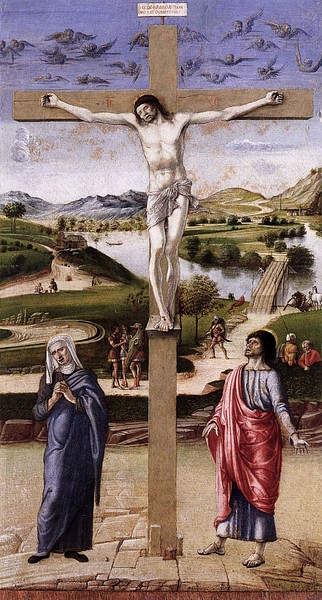
Our earliest literature for what would become Christianity is found in the letters of Paul the Apostle (c. 50s-60s CE). A Pharisee who experienced a vision of Christ in heaven (the Greek term for messiah, Christos), claimed that he was commissioned to be the apostle (herald) to the Gentiles (non-Jews). According to the prophets, Gentiles could join Israel when God instituted his kingdom on earth. They did not have to have the physical identity markers of Jews (circumcision, dietary laws, or Sabbath observance), but Paul's communities did have to cease all sacrifices to the traditional gods. At this stage, this was not monotheism. Paul upheld the existence of other gods; he berated them for interfering at times with his mission. It was the sacrifices to these other gods that were no longer valid in Paul's concepts of salvation.
Paul introduced an innovation to Jewish traditions. Christ was pre-existent and present with God from creation, who humbled himself to appear as a man on earth and died as a sacrifice to atone for Adam's sin, which had brought death into the world (Romans 5). He was "given the name that is above every name" (the Tetragrammaton, Yahweh). At the sound of the name of Christ, "every knee should bend" in an age-old concept of bowing down before images of the gods (Philippians 2). Paul utilized a Jewish concept that God was selfless; God himself became manifest in the earthly Jesus. This was why Jesus was worthy of worship. The preface of the Gospel of John utilized the concept of the divine logos, in what became the doctrine of Incarnation (Christ taking on flesh).
The separation of Christianity from Judaism occurred in the 2nd century CE, through the work of Christian leaders who no longer had ethnic connections to Judaism. They retained the traditions of God from the Scriptures but combined these with aspects of the philosophical high god. At the time, Christians were being persecuted by Rome for their refusal to participate in the state and imperial cults. Julius Caesar (100-44 BCE) had earlier exempted the Jews, and Christians petitioned magistrates and the Roman emperor that they should be granted the same exception, as they were verus Israel, "the true Jews" of God's covenant. Through allegory, the Church Fathers could 'prove' that everything in the history and story of Israel (the Scriptures) indicated a type of the pre-existent Christ. What distinguished Christians from Jews was that Christians were no longer held to the literal Law of Moses. God had established a new covenant with his people that upended the traditional practices. At the same time, with the ban on all idolatry, Christianity also separated itself from the dominant culture.
Trinity
Early Christianity experienced a series of continuing debates and conflicts over ways in which to express the oneness of God and yet allow for the simultaneous divinity and worship of Christ. A presbyter in Alexandria, Arius, was teaching that if you believed that everything in the universe was created by the God of Israel, then at some point he must have created Christ. This made Christ a creature, subservient to God. Riots over this teaching occurred in some cities, and Constantine I (r. 306-337 CE) called for the First Council of Nicaea in 325 CE. In maintaining the Jewish tradition of worshipping only one God, Christians constructed the concept known as the Trinity, which described the relationship of God to Christ, the origins of Christ, and an essence known as the Holy Spirit.
The debate boiled down to two choices: was Christ homo-iousios, an essence like the father's, or was he homo-ousios, of one substance identical to the father's? (Notice that the difference in these two words boils down to one "i," an iota). The Council opted for the second choice in that God and Christ were identical in essence (substance) and that Christ was a manifestation of God himself on earth. While the Bishops were in attendance, Constantine had them formulate what became known as the Nicene Creed (from the first word Credo, "I believe"). This was an innovation; in the ancient world, there was no central authority to dictate what everyone should believe. As both head of the state and head of the Church, Constantine now had the authority to make it mandatory for every Christian. In a system where traditional sacrifices and rituals had been eliminated, belief became an important concept.
In traditional Judaism, the "spirit of God" was understood as the way in which God empowered individuals and actions, such as the spirit that animated Adam when he was created and God's possession of the prophets. From the beginning of the Christian movement, believers had experienced this power as gifts from God, in their ability to prophesize, teach, speak in tongues, heal, and raise people from the dead. The creed held God as one, but with three aspects: God the father, Christ the son, and the Holy Spirit.
God in Islam
Islam emerged as a reform movement of both Judaism and Christianity through revelations (the Quran) to the Prophet Muhammad in the Arabian peninsula in the 6th century CE. The Arabic Allah most likely derived from al-ʾilāh, "the God" related to el. Ilah meant "deity;" the al addition distinguished this deity from others. The Quran (considered sacred) was created as the eventual writing down of the revelations.
The dominant concept of Allah is tawhid, "oneness." This is declared in one of the pillars of Islam, the shahada, which states there is no god but God and Muhammad is His prophet. "Say: He is God, the One; God, the Eternal, the Absolute; He begot no one, nor is he begotten; Nor is there anyone equivalent to him." (112:4) Any concept or activity that comes close to idolatry is shirk ("making a partner"). There is no official priesthood in Islam, as there are no human intermediaries between God and humans. Imams are spiritual guides in the communities. Islam retains the existence of angels as messengers of God and honors the traditional patriarchs and prophets, with Muhammad the last of the prophets.
While using masculine principles of Arabic, God has no physical body parts or gender and transcends all: "There is nothing whatever like him, and he is the One that hears and sees [all things]" (42:11). The concept of Qadim ("ancient") implies eternity with no beginning and no end; normal boundaries and measurement cannot be applied to God. Thus, the ban on anthropomorphic descriptions, idolatry, and images was retained; these are incomplete attempts to describe something that was perfectly complete and unique. The ultimate source of existence, Allah is the uncaused cause, who created everything out of nothing, who is immutable and perfect. The most popular descriptors of an attribute of Allah are "compassionate" and "merciful." As in Judaism and Christianity, Islam promotes the concept of a future reign of Allah on earth and a final judgment.


